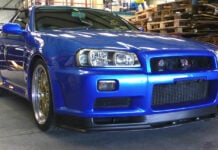Oscar Wilde once called America and Britain “two nations divided by a common language”. Thanks to the influence of movies, TV and the internet, that’s one problem UK drivers in the US won’t have in the 21st century – no one’s likely to be left scratching their heads when confronted by terms like ‘fender’, ‘sidewalk’ or ‘hood’ any more. But there are some key differences between the two nations’ driving laws and habits that you’ll definitely want to be aware of before you start putting pedal to metal on the freeway.
What paperwork will I need?
To drive in the US you’ll need to be a minimum of 16 years old, and in possession of a full UK driving licence. Technically speaking, most drivers will not need an International Driving Permit, unless they’re visiting Florida, or still have one of the older, non-photographic UK licences. But they’re highly recommended for all drivers anyway, because in the event that you need to make an insurance claim having this document will make your life a lot easier.
You’ll also need to ensure that you have up-to-date travel/health insurance, as there is no reciprocal healthcare agreement between the two nations. We can’t stress this enough, because US medical bills can very quickly reach eye-watering levels. In a highly litigious culture, we’d also suggest opting for the most comprehensive car/driving insurance you can possibly afford.
When in Rome…
Florida’s law about International Driving Permits highlights a trap that many first-time visitors fall into. People tend to think of the USA as a country like France, Kenya or Sweden, whereas it’s actually more like the EU: a set of nations (‘states’) that are bound by some common (‘federal’) laws, but whose own internal laws can vary considerably.
Even such basic laws as the minimum driving age and the motorway speed limit can change from state-to-state, so you’re strongly advised to look up the local laws in every state you intend to visit – even if you’re just passing across a corner of it for an hour or two – before you set off on your journey.
Key differences
One of the first big differences UK drivers will notice is that America doesn’t go in for roundabouts much: instead, major junctions are usually just straight four-way intersections. Be aware that in the absence of turn signals telling you otherwise, it’s permissible in the USA to turn right on a red light. Bear in mind also that US traffic lights go straight from red to green, with no ‘red and amber’ in-between, so be ready to move.
What may also throw you at first is that there is no law against undertaking in the USA, and other drivers can and will undertake you regularly. This means you need to be fully aware of all vehicles on both sides at all times; it also makes signalling your own intention to change lanes even more crucial than it is in the UK.
Some US states, including New Jersey and California, paint their kerbs different colours to show what parking/stopping regulations apply on that stretch of road. What those colour codes mean varies from state to state, so again – do your local homework before you travel.
Behave yourself
Many of us of a certain age have fond memories of the TV show CHiPS, but the daily reality of life as a US highway patrolman isn’t exhilarating high-speed chases and uncovering international crime syndicates – it’s mostly issuing tickets for speeding and drink-driving. Be aware that while speed limits do vary from state-to-state, they’re always rigorously enforced, with no unofficial ‘grace period’ if you’re just a couple of miles an hour over the limit. The same goes for drink-driving, where in some states the acceptable blood alcohol limit is just 0.05%. So erring on the side of caution is advised.
Given the USA’s armed police and ubiquitious gun culture, getting stopped by the police also tends to be a slightly more stressful experience than it is in Britain. If you do get pulled over, then stop in front of the police car, stay in your vehicle and keep your hands on the wheel and visible until the officer knocks on your window.
What not to pack
Speed camera detectors are illegal everywhere in the USA. If you’re caught with one, even if you’re not actively using it, you’ll have it confiscated and have to pay a fine.
If you can get all of the above right, though, then driving in the US needn’t be overly stressful. You will at least be able to read all the street signs and converse with a mechanic in your own language if you need to, while parking in cities and towns is generally much easier than it is in crowded Britain. Plus, there’s the fact that petrol’s around half the price… so enjoy your drive!
If you are shipping your car to the USA, please contact us here at Autoshippers for a car shipping quote and details of our car shipping services.










